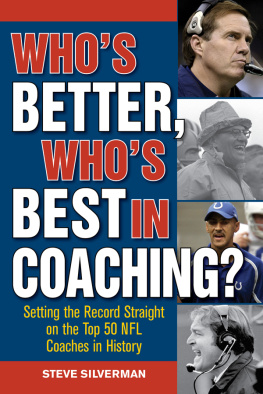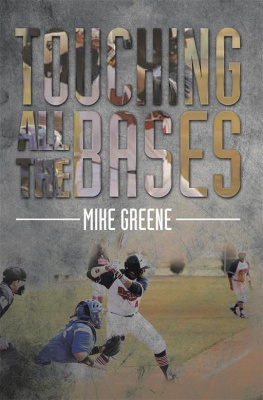Copyright 2015 by Steve Silverman
All rights reserved. No part of this book may be reproduced in any manner without the express written consent of the publisher, except in the case of brief excerpts in critical reviews or articles. All inquiries should be addressed to Sports Publishing, 307 West 36th Street, 11th Floor, New York, NY 10018.
Sports Publishing books may be purchased in bulk at special discounts for sales promotion, corporate gifts, fund-raising, or educational purposes. Special editions can also be created to specifications. For details, contact the Special Sales Department, Sports Publishing, 307 West 36th Street, 11th Floor, New York, NY 10018 or .
Sports Publishing is a registered trademark of Skyhorse Publishing, Inc., a Delaware corporation.
Visit our website at www.sportspubbooks.com.
10 9 8 7 6 5 4 3 2 1
Library of Congress Cataloging-in-Publication Data is available on file.
Cover design by Owen Corrigan
Cover photo credit AP Images
ISBN: 978-1-61321-764-1
Ebook ISBN: 978-1-61321-787-0
Printed in the United States of America
CONTENTS
# 1
VINCE LOMBARDI
T here is little doubt that Vince Lombardi was the most compelling coach in the history of the NFL, and perhaps the greatest coach and leader in the history of all North American sports, let alone professional football.
His talent and prowess were not in his ability to draw up explosive and scintillating plays. There were many coaches who had far more to offer in that area, but when it came to getting his players to prepare well and execute at their best on an every-week basis, Lombardi set a standard that no other coach has been able to sustain.
Lombardi also had an eye for execution. When his teams practiced, he made sure that each player got it right before he moved on to the next play.
That was the Lombardi way, and those who played for him in Green Bay from 1959 through 1967, or in Washington in 1969, quickly learned that there was only one way to get things done. Those who chose to try to get by or to put one over on Lombardi did not last long under his watchful eye.
Lombardi had been the offensive coordinator of the New York Giants under Jim Lee Howell in the late 1950s. While Lombardi coached the offense, Tom Landry ran the defense and the two competed hard against each other, something that would play out quite a bit during the 1960s.
There was a strong impression that Lombardi would eventually become head coach of the Giants, and that would have pleased the New Jersey native quite a bit. However, the lowly Green Bay Packers came calling in 1959, and Lombardi seized the opportunity even though the Packers had not had a winning season since 1947.
It was assumed that Lombardi was inheriting a mess of a team, but he didnt see it that way once he arrived at training camp that year. Instead, he saw the Packers as a fairly talented team that had lacked direction and discipline.
Lombardi provided both of those characteristics and did it with gusto. He simplified the Green Bay offense and had his team work on the basic fundamentals of the gameblocking and tackling. The power sweep was his bread and butter play, and he would run it again and again in practice so that each player knew where he was supposed to be as a matter of instinct.
That play featured the offensive guards pulling out from the line of scrimmage and running toward the sidelines, where they would kick out opposing linebackers or defensive backs and seal off an alley for the running back to attack with gusto.
Lombardi said the power sweep was his top play because each of his eleven players was required to do his job in order to make it work. The actions of the team, rather than the players as individuals, is why Lombardi loved the game.
Its all about teamwork, Lombardi said. Individual commitment to a group effortthat is what makes a team work, a company work, a society work, a civilization work.
Lombardis influence on the Packers was felt immediately. He drove his men hard in his initial training camp at St. Norberts College in DePere, Wisconsin, but his players also knew there was something different about this coach. Angry, gruff, demanding, and intimidating, Lombardi also cared deeply about his players. It may not have shown on the surface, but his players learned this quickly.
Green Bay went 7-5-0 in 1959, and the rest of the league took notice of what Lombardi was doing with his team. He turned Bart Starr, a 17th-round draft choice selected in 1956, into his starting quarterback. Starr may not have been a strong-armed quarterback, but he was an accurate passer who played the game with intelligence. He also had substantial leadership ability, which Lombardi recognized and appreciated.
In addition, he had two gifted running backs in Paul Hornung and Jim Taylor, and both of them knew how to run the power sweep. The defense was tough, mean, and aggressive. By the 1960 season, the Packers were on their way to becoming a juggernaut. They won the West Division with an 8-4-0 record, setting the stage for their matchup with the Philadelphia Eagles in the NFL Championship game.
Green Bay dropped a 17-13 decision, but the Packers had the ball in the final moments and came up just short in their bid to win the game.
The Packers never lost another postseason game under Lombardi.
Green Bay became a dominant team in 1961 and 62, as they would go 11-3 and 13-1 in the next two seasons. They would overwhelm the Giants 37-0 in the 61 championship game and repeat their title the following year with a closer 16-7 win over the Giants.
Lombardi strived to win championships, but he was never satisfied because winning a particular game or a title was never his long-term goal. He was all about achieving perfection, and while that can never be sustained on the football field, his demanding practices meant that there would never be any satisfaction among his players or his coaches.
He made them all work to a higher standard, and it paid off dramatically.
While the Packers did not win the title in 63 or 64, those failures just prepared his team for what was to come. Green Bay finished 10-3-1 in 1965, and that left them tied with the Baltimore Colts for the West Division title.
That meant the two teams had to engage in a playoff to break the tie, and neither team had its starting quarterback. The Colts, coached by young Don Shula, had neither starter Johnny Unitas nor backup Gary Cuozzo, while Starr was injured for the Packers. Green Bay backup quarterback Zeke Bratkowski led the Packers to a 13-10 overtime victory.
The Packers pounced on their opportunity and rolled over the Cleveland Browns 23-12 in the NFL Championship game.
The following year, the Packers were a sensational team and won the West Division with a 12-2 record. Lombardi took his Packers to Dallas to play Landrys Cowboys in the NFL Championship game, and the two teams slugged it out for 60 minutes.
The Packers had played one of their best offensive games and had a 34-27 lead in the late going at the Cotton Bowl, but the Cowboys had the ball and Don Meredith was driving them to possibly tie the score and send the game to overtime.
However, linebacker Dave Robinson stormed into the backfield on a 4th-and-goal play from the two-yard line, and Packers defensive back Tom Brown was able to intercept Merediths wobbly pass. That clinched the title for the Packers, and it gave them a chance to play in the first Super Bowl against the Kansas City Chiefs.
There was intense pressure under Lombardi. He was not only trying to get the Packers an important win, but he was also coaching to uphold the honor of the NFL over the upstart American Football League. While the Packers were considered the better team, it was basically a no-win situation for Lombardi. If he and the Packers won, they would have been doing the expected. If they lost, they would have let down the entire NFL.










